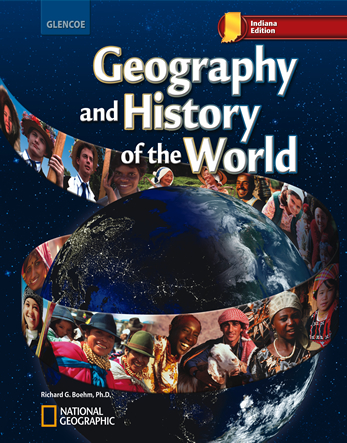 
Geography and History of the World © 2010 Indiana EditionChapter 23:
Physical Geography of South AsiaWeb Activity Lesson Plans"Mount Everest" Introduction
Students have read about the mountains of South Asia, including Mount Everest
in the Himalaya. In this activity they will learn about the movement of tectonic
plates that formed the Himalaya, the effects of glaciers, and the history and
physical geography of climbing Mount Everest. They will also learn about the challenges
that the physical geography poses to climbers.
Lesson Description
Students will use information from the PBS Nova Online Adventure Web site to learn
about the Himalaya and Mount Everest. Students will answer four questions and
then use what they have learned to write a short story about reaching the summit
of Mount Everest.
Instructional Objectives - Students will be able to describe the physical forces that formed and shaped
the Himalaya.
- Students will be able to discuss the physical geography of Mount Everest
and how it influences the routes climbers take to the summit.
Applied Content Standards
Standard 1: The geographically informed person knows and understands how to use
maps and other geographic representations, tools, and technologies to acquire,
process, and report information from a spatial perspective.
Standard 4: The geographically informed person knows and understands the physical
and human characteristics of places.
Standard 7: The geographically informed person knows and understands the physical
processes that shape the patterns of Earth's surface.
Standard 17: The geographically informed person knows and understands how to apply
geography to interpret the past.
Student Web Activity Answers- The tectonic plate underneath India collided with southern Asia and slipped
beneath the Asian plate. As the two plates pushed against each other, heavy
sediments in the earth's crust were forced upward, forming the Himalaya. Glaciers
weighing millions of tons moved through the mountains, scraping the mountains
and removing rocks. As a result, the size of the Himalaya today is much smaller
than when first formed.
- The tectonic plates continue to push against each other, and this movement
causes earthquakes.
- Present-day mountaineers encounter snow and ice, routes that are steep or
nearly vertical, jagged or rocky terrain, routes along narrow ridges with
steep drops on either side, crevasses in the ice, strong winds, avalanches,
and even heat in some areas on windless days.
- Early mountaineers faced several challenges. They did not know whether a
route to the summit could be found. Little was known about the effects of
high altitude on the human body, and early climbers suffered illness and even
death. The equipment and clothing they used is considered primitive today
and did not offer much protection. At times Tibet and Nepal did not allow
outsiders access to Mount Everest.
- Students' stories will vary but should include details about the physical
geography of the route, the challenges faced by the climbers, and the view
from the summit.
 |  |
|


















